Managing Financial Resources: Ratio Analysis, Costing, Investment Appraisal
VerifiedAdded on 2023/06/08
|8
|2394
|451
AI Summary
This report covers scenarios and techniques for managing financial resources, including Ratio Analysis, Costing, and Investment Appraisal. It explains how these methods can improve organizational performance and contribute to the growth of a firm. The report includes examples and benefits of each technique, as well as their applications in different scenarios. The subject is Managing Financial Resources, and the course code, name, and college/university are not mentioned.
Contribute Materials
Your contribution can guide someone’s learning journey. Share your
documents today.
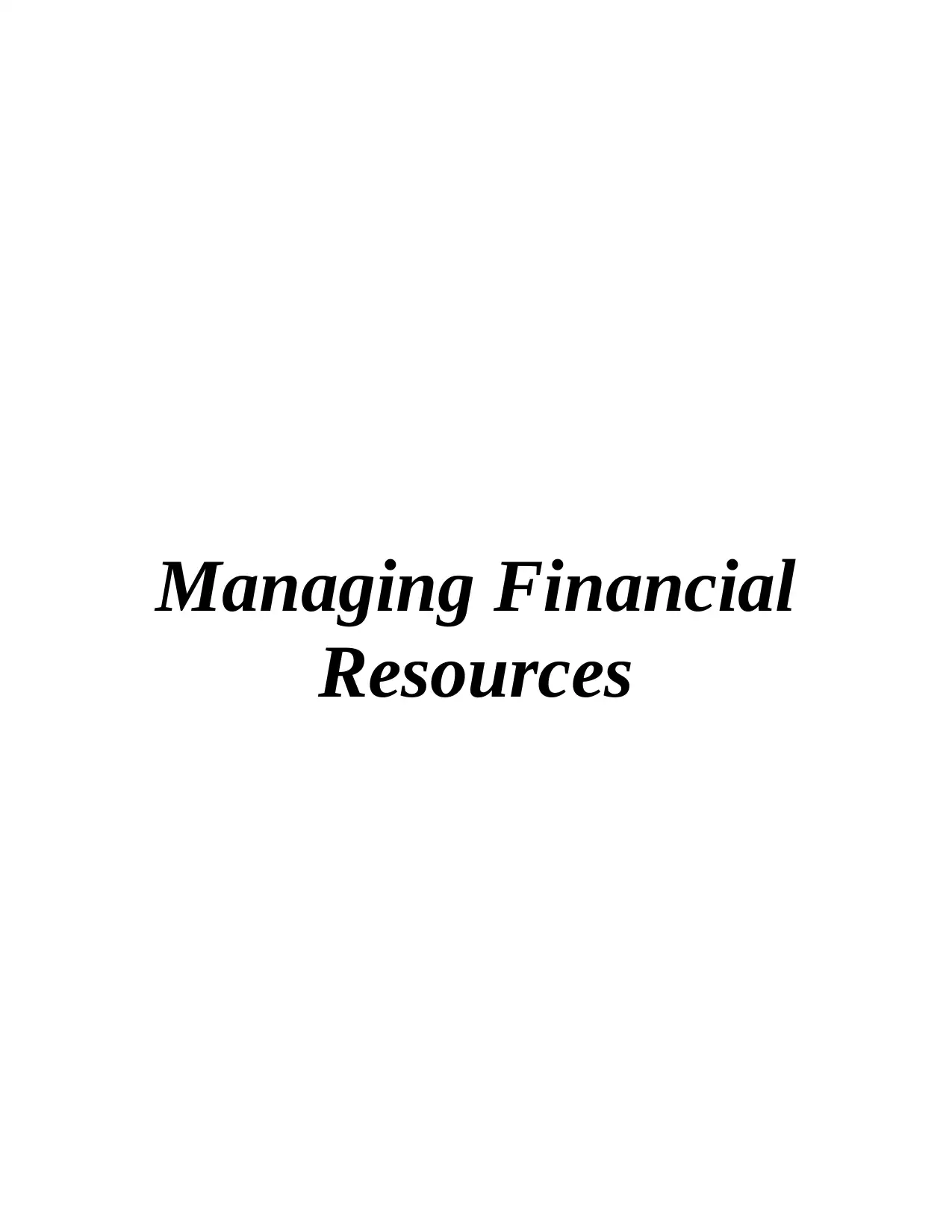
Managing Financial
Resources
Resources
Secure Best Marks with AI Grader
Need help grading? Try our AI Grader for instant feedback on your assignments.
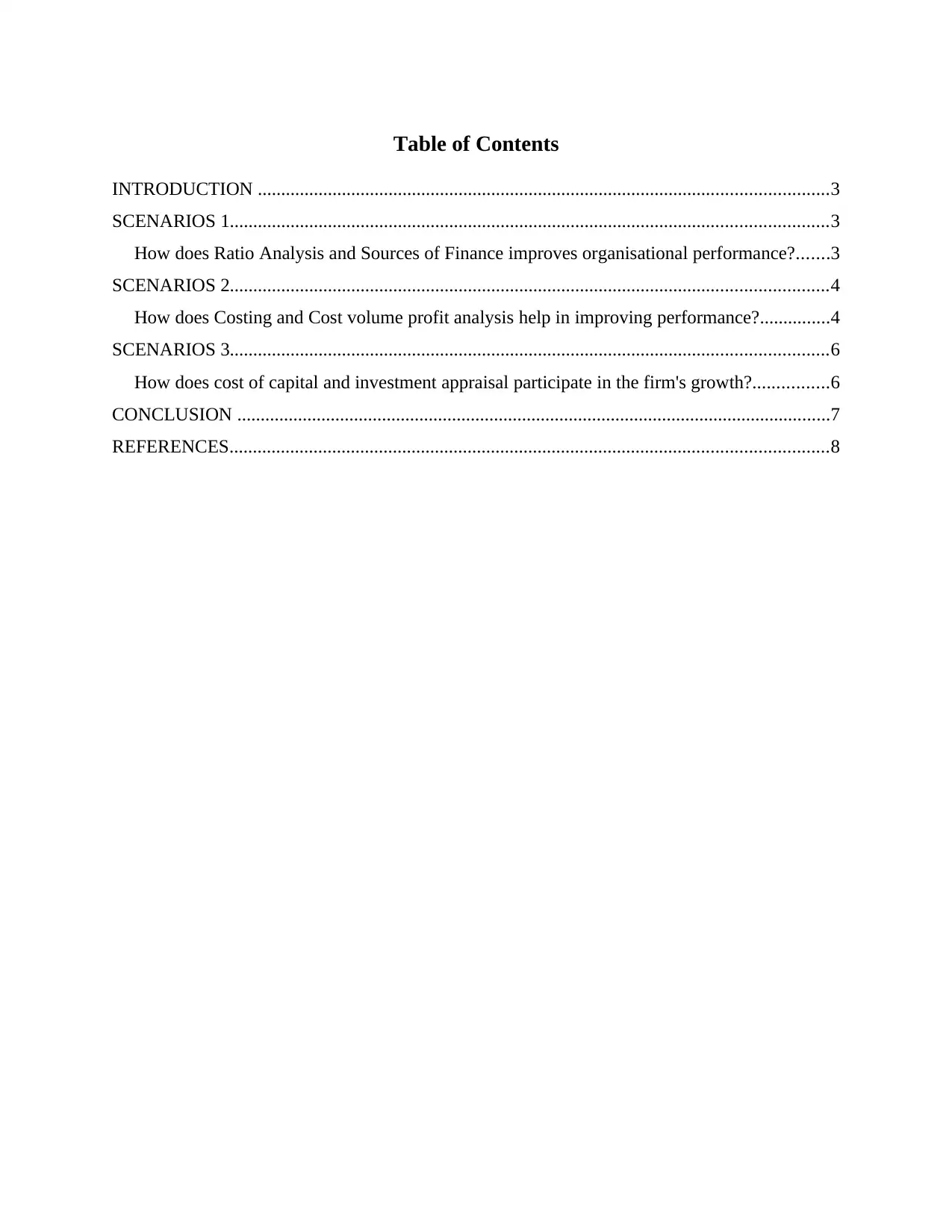
Table of Contents
INTRODUCTION ..........................................................................................................................3
SCENARIOS 1................................................................................................................................3
How does Ratio Analysis and Sources of Finance improves organisational performance?.......3
SCENARIOS 2................................................................................................................................4
How does Costing and Cost volume profit analysis help in improving performance?...............4
SCENARIOS 3................................................................................................................................6
How does cost of capital and investment appraisal participate in the firm's growth?................6
CONCLUSION ...............................................................................................................................7
REFERENCES................................................................................................................................8
INTRODUCTION ..........................................................................................................................3
SCENARIOS 1................................................................................................................................3
How does Ratio Analysis and Sources of Finance improves organisational performance?.......3
SCENARIOS 2................................................................................................................................4
How does Costing and Cost volume profit analysis help in improving performance?...............4
SCENARIOS 3................................................................................................................................6
How does cost of capital and investment appraisal participate in the firm's growth?................6
CONCLUSION ...............................................................................................................................7
REFERENCES................................................................................................................................8
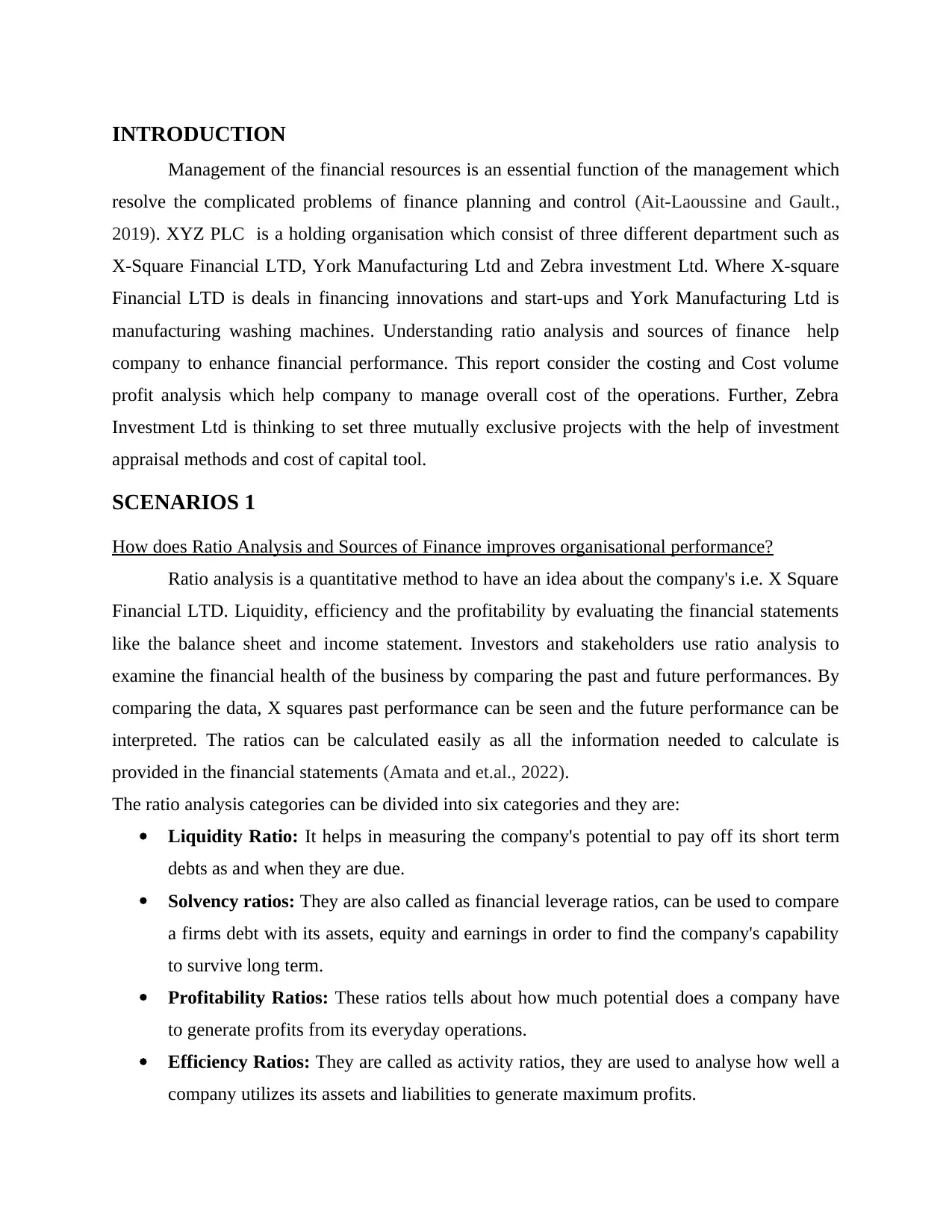
INTRODUCTION
Management of the financial resources is an essential function of the management which
resolve the complicated problems of finance planning and control (Ait-Laoussine and Gault.,
2019). XYZ PLC is a holding organisation which consist of three different department such as
X-Square Financial LTD, York Manufacturing Ltd and Zebra investment Ltd. Where X-square
Financial LTD is deals in financing innovations and start-ups and York Manufacturing Ltd is
manufacturing washing machines. Understanding ratio analysis and sources of finance help
company to enhance financial performance. This report consider the costing and Cost volume
profit analysis which help company to manage overall cost of the operations. Further, Zebra
Investment Ltd is thinking to set three mutually exclusive projects with the help of investment
appraisal methods and cost of capital tool.
SCENARIOS 1
How does Ratio Analysis and Sources of Finance improves organisational performance?
Ratio analysis is a quantitative method to have an idea about the company's i.e. X Square
Financial LTD. Liquidity, efficiency and the profitability by evaluating the financial statements
like the balance sheet and income statement. Investors and stakeholders use ratio analysis to
examine the financial health of the business by comparing the past and future performances. By
comparing the data, X squares past performance can be seen and the future performance can be
interpreted. The ratios can be calculated easily as all the information needed to calculate is
provided in the financial statements (Amata and et.al., 2022).
The ratio analysis categories can be divided into six categories and they are:
Liquidity Ratio: It helps in measuring the company's potential to pay off its short term
debts as and when they are due.
Solvency ratios: They are also called as financial leverage ratios, can be used to compare
a firms debt with its assets, equity and earnings in order to find the company's capability
to survive long term.
Profitability Ratios: These ratios tells about how much potential does a company have
to generate profits from its everyday operations.
Efficiency Ratios: They are called as activity ratios, they are used to analyse how well a
company utilizes its assets and liabilities to generate maximum profits.
Management of the financial resources is an essential function of the management which
resolve the complicated problems of finance planning and control (Ait-Laoussine and Gault.,
2019). XYZ PLC is a holding organisation which consist of three different department such as
X-Square Financial LTD, York Manufacturing Ltd and Zebra investment Ltd. Where X-square
Financial LTD is deals in financing innovations and start-ups and York Manufacturing Ltd is
manufacturing washing machines. Understanding ratio analysis and sources of finance help
company to enhance financial performance. This report consider the costing and Cost volume
profit analysis which help company to manage overall cost of the operations. Further, Zebra
Investment Ltd is thinking to set three mutually exclusive projects with the help of investment
appraisal methods and cost of capital tool.
SCENARIOS 1
How does Ratio Analysis and Sources of Finance improves organisational performance?
Ratio analysis is a quantitative method to have an idea about the company's i.e. X Square
Financial LTD. Liquidity, efficiency and the profitability by evaluating the financial statements
like the balance sheet and income statement. Investors and stakeholders use ratio analysis to
examine the financial health of the business by comparing the past and future performances. By
comparing the data, X squares past performance can be seen and the future performance can be
interpreted. The ratios can be calculated easily as all the information needed to calculate is
provided in the financial statements (Amata and et.al., 2022).
The ratio analysis categories can be divided into six categories and they are:
Liquidity Ratio: It helps in measuring the company's potential to pay off its short term
debts as and when they are due.
Solvency ratios: They are also called as financial leverage ratios, can be used to compare
a firms debt with its assets, equity and earnings in order to find the company's capability
to survive long term.
Profitability Ratios: These ratios tells about how much potential does a company have
to generate profits from its everyday operations.
Efficiency Ratios: They are called as activity ratios, they are used to analyse how well a
company utilizes its assets and liabilities to generate maximum profits.
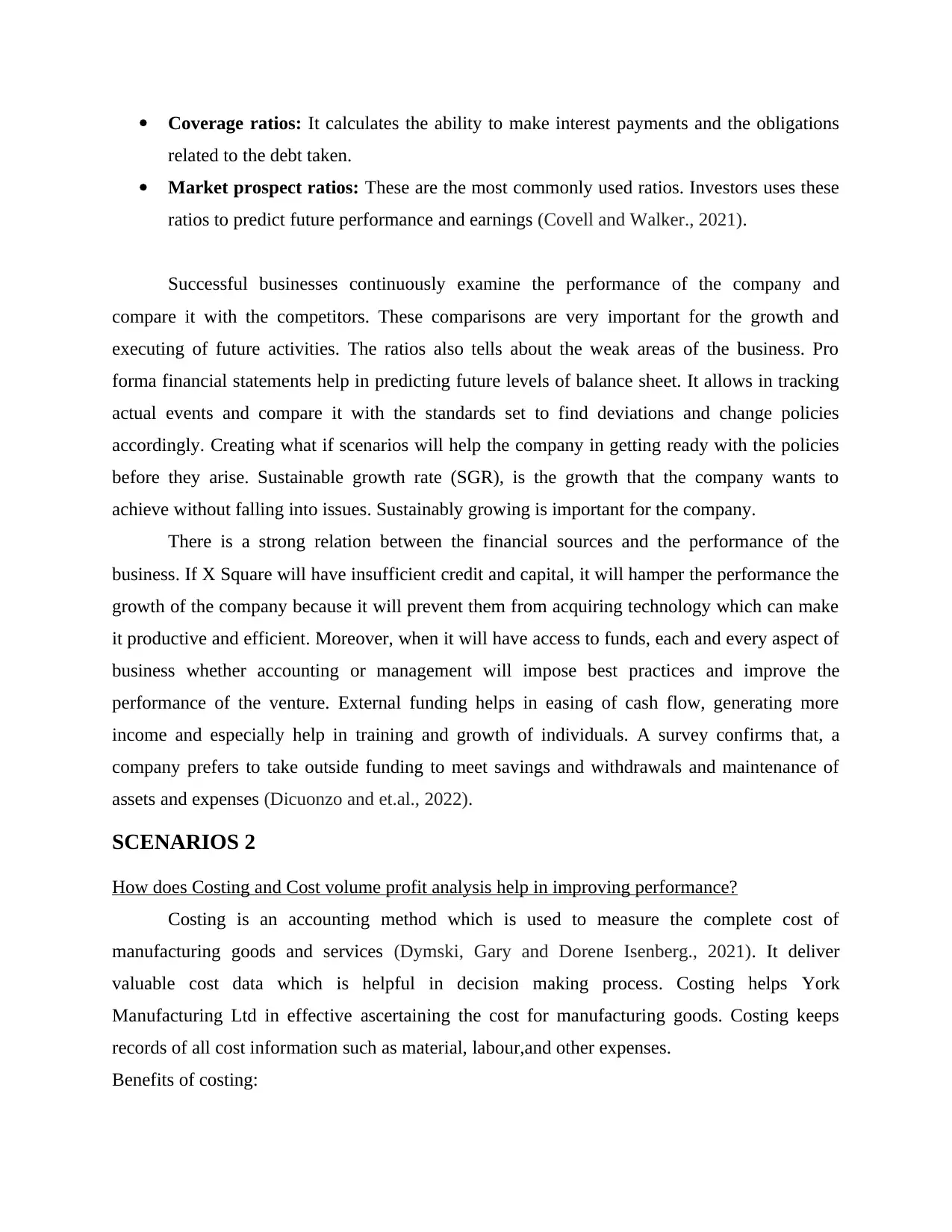
Coverage ratios: It calculates the ability to make interest payments and the obligations
related to the debt taken.
Market prospect ratios: These are the most commonly used ratios. Investors uses these
ratios to predict future performance and earnings (Covell and Walker., 2021).
Successful businesses continuously examine the performance of the company and
compare it with the competitors. These comparisons are very important for the growth and
executing of future activities. The ratios also tells about the weak areas of the business. Pro
forma financial statements help in predicting future levels of balance sheet. It allows in tracking
actual events and compare it with the standards set to find deviations and change policies
accordingly. Creating what if scenarios will help the company in getting ready with the policies
before they arise. Sustainable growth rate (SGR), is the growth that the company wants to
achieve without falling into issues. Sustainably growing is important for the company.
There is a strong relation between the financial sources and the performance of the
business. If X Square will have insufficient credit and capital, it will hamper the performance the
growth of the company because it will prevent them from acquiring technology which can make
it productive and efficient. Moreover, when it will have access to funds, each and every aspect of
business whether accounting or management will impose best practices and improve the
performance of the venture. External funding helps in easing of cash flow, generating more
income and especially help in training and growth of individuals. A survey confirms that, a
company prefers to take outside funding to meet savings and withdrawals and maintenance of
assets and expenses (Dicuonzo and et.al., 2022).
SCENARIOS 2
How does Costing and Cost volume profit analysis help in improving performance?
Costing is an accounting method which is used to measure the complete cost of
manufacturing goods and services (Dymski, Gary and Dorene Isenberg., 2021). It deliver
valuable cost data which is helpful in decision making process. Costing helps York
Manufacturing Ltd in effective ascertaining the cost for manufacturing goods. Costing keeps
records of all cost information such as material, labour,and other expenses.
Benefits of costing:
related to the debt taken.
Market prospect ratios: These are the most commonly used ratios. Investors uses these
ratios to predict future performance and earnings (Covell and Walker., 2021).
Successful businesses continuously examine the performance of the company and
compare it with the competitors. These comparisons are very important for the growth and
executing of future activities. The ratios also tells about the weak areas of the business. Pro
forma financial statements help in predicting future levels of balance sheet. It allows in tracking
actual events and compare it with the standards set to find deviations and change policies
accordingly. Creating what if scenarios will help the company in getting ready with the policies
before they arise. Sustainable growth rate (SGR), is the growth that the company wants to
achieve without falling into issues. Sustainably growing is important for the company.
There is a strong relation between the financial sources and the performance of the
business. If X Square will have insufficient credit and capital, it will hamper the performance the
growth of the company because it will prevent them from acquiring technology which can make
it productive and efficient. Moreover, when it will have access to funds, each and every aspect of
business whether accounting or management will impose best practices and improve the
performance of the venture. External funding helps in easing of cash flow, generating more
income and especially help in training and growth of individuals. A survey confirms that, a
company prefers to take outside funding to meet savings and withdrawals and maintenance of
assets and expenses (Dicuonzo and et.al., 2022).
SCENARIOS 2
How does Costing and Cost volume profit analysis help in improving performance?
Costing is an accounting method which is used to measure the complete cost of
manufacturing goods and services (Dymski, Gary and Dorene Isenberg., 2021). It deliver
valuable cost data which is helpful in decision making process. Costing helps York
Manufacturing Ltd in effective ascertaining the cost for manufacturing goods. Costing keeps
records of all cost information such as material, labour,and other expenses.
Benefits of costing:
Secure Best Marks with AI Grader
Need help grading? Try our AI Grader for instant feedback on your assignments.
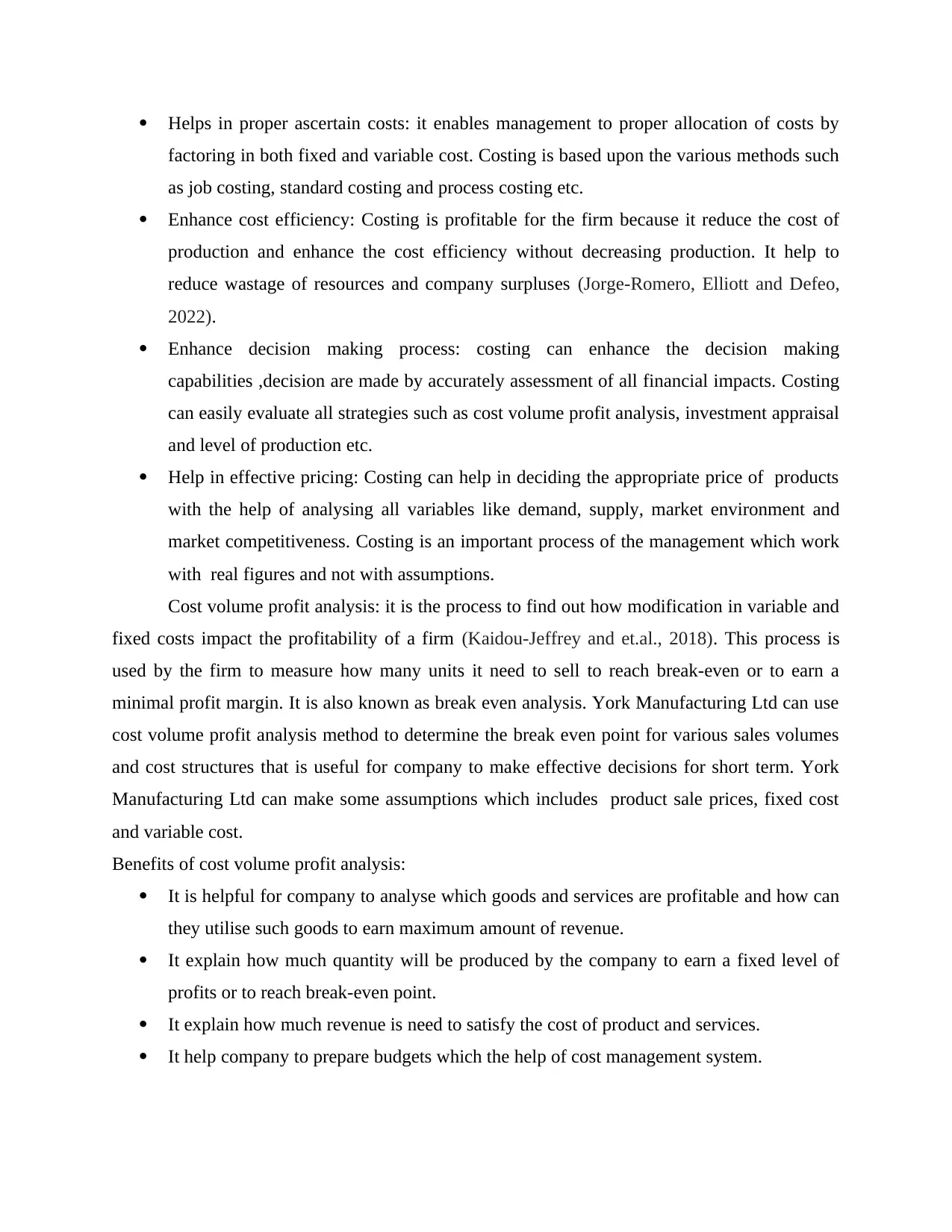
Helps in proper ascertain costs: it enables management to proper allocation of costs by
factoring in both fixed and variable cost. Costing is based upon the various methods such
as job costing, standard costing and process costing etc.
Enhance cost efficiency: Costing is profitable for the firm because it reduce the cost of
production and enhance the cost efficiency without decreasing production. It help to
reduce wastage of resources and company surpluses (Jorge-Romero, Elliott and Defeo,
2022).
Enhance decision making process: costing can enhance the decision making
capabilities ,decision are made by accurately assessment of all financial impacts. Costing
can easily evaluate all strategies such as cost volume profit analysis, investment appraisal
and level of production etc.
Help in effective pricing: Costing can help in deciding the appropriate price of products
with the help of analysing all variables like demand, supply, market environment and
market competitiveness. Costing is an important process of the management which work
with real figures and not with assumptions.
Cost volume profit analysis: it is the process to find out how modification in variable and
fixed costs impact the profitability of a firm (Kaidou-Jeffrey and et.al., 2018). This process is
used by the firm to measure how many units it need to sell to reach break-even or to earn a
minimal profit margin. It is also known as break even analysis. York Manufacturing Ltd can use
cost volume profit analysis method to determine the break even point for various sales volumes
and cost structures that is useful for company to make effective decisions for short term. York
Manufacturing Ltd can make some assumptions which includes product sale prices, fixed cost
and variable cost.
Benefits of cost volume profit analysis:
It is helpful for company to analyse which goods and services are profitable and how can
they utilise such goods to earn maximum amount of revenue.
It explain how much quantity will be produced by the company to earn a fixed level of
profits or to reach break-even point.
It explain how much revenue is need to satisfy the cost of product and services.
It help company to prepare budgets which the help of cost management system.
factoring in both fixed and variable cost. Costing is based upon the various methods such
as job costing, standard costing and process costing etc.
Enhance cost efficiency: Costing is profitable for the firm because it reduce the cost of
production and enhance the cost efficiency without decreasing production. It help to
reduce wastage of resources and company surpluses (Jorge-Romero, Elliott and Defeo,
2022).
Enhance decision making process: costing can enhance the decision making
capabilities ,decision are made by accurately assessment of all financial impacts. Costing
can easily evaluate all strategies such as cost volume profit analysis, investment appraisal
and level of production etc.
Help in effective pricing: Costing can help in deciding the appropriate price of products
with the help of analysing all variables like demand, supply, market environment and
market competitiveness. Costing is an important process of the management which work
with real figures and not with assumptions.
Cost volume profit analysis: it is the process to find out how modification in variable and
fixed costs impact the profitability of a firm (Kaidou-Jeffrey and et.al., 2018). This process is
used by the firm to measure how many units it need to sell to reach break-even or to earn a
minimal profit margin. It is also known as break even analysis. York Manufacturing Ltd can use
cost volume profit analysis method to determine the break even point for various sales volumes
and cost structures that is useful for company to make effective decisions for short term. York
Manufacturing Ltd can make some assumptions which includes product sale prices, fixed cost
and variable cost.
Benefits of cost volume profit analysis:
It is helpful for company to analyse which goods and services are profitable and how can
they utilise such goods to earn maximum amount of revenue.
It explain how much quantity will be produced by the company to earn a fixed level of
profits or to reach break-even point.
It explain how much revenue is need to satisfy the cost of product and services.
It help company to prepare budgets which the help of cost management system.
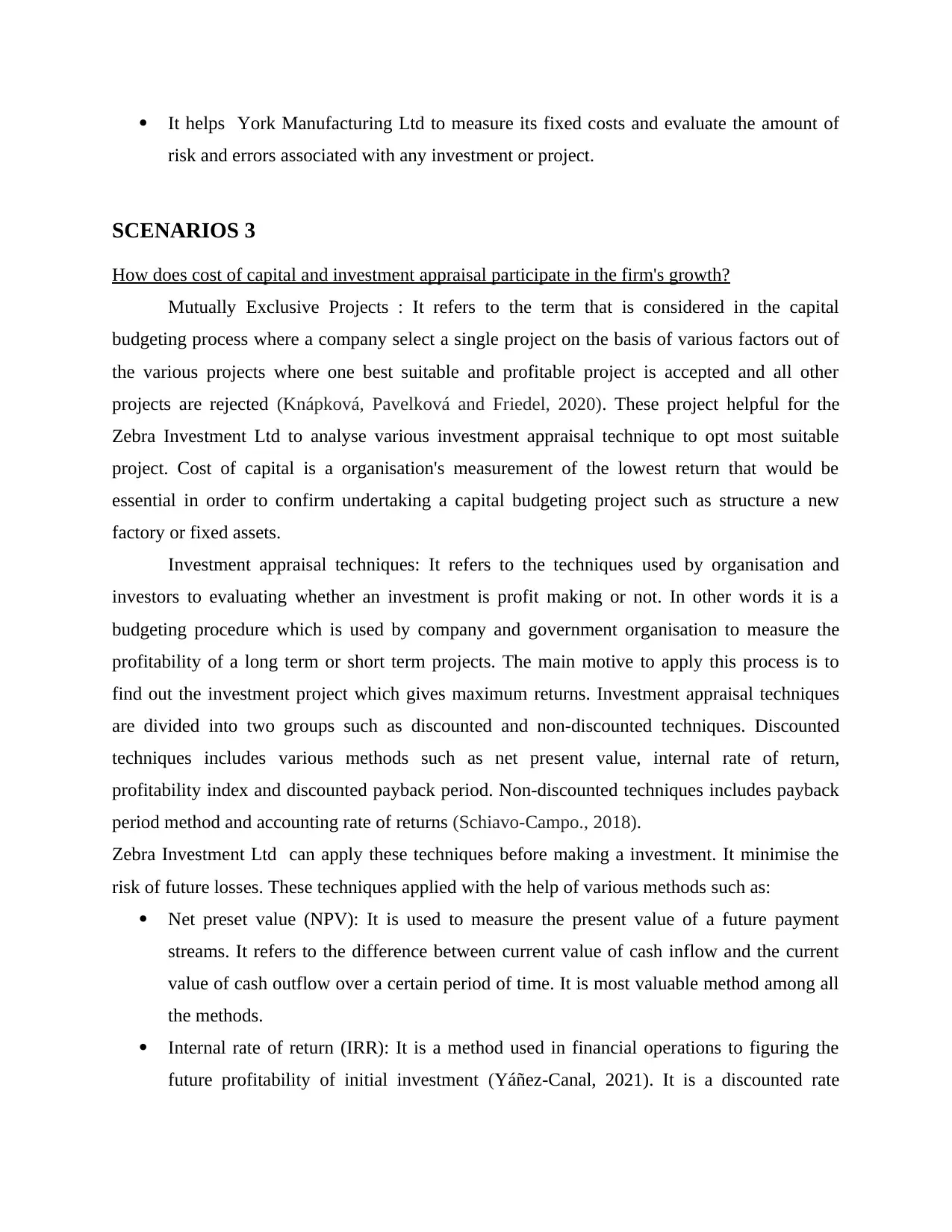
It helps York Manufacturing Ltd to measure its fixed costs and evaluate the amount of
risk and errors associated with any investment or project.
SCENARIOS 3
How does cost of capital and investment appraisal participate in the firm's growth?
Mutually Exclusive Projects : It refers to the term that is considered in the capital
budgeting process where a company select a single project on the basis of various factors out of
the various projects where one best suitable and profitable project is accepted and all other
projects are rejected (Knápková, Pavelková and Friedel, 2020). These project helpful for the
Zebra Investment Ltd to analyse various investment appraisal technique to opt most suitable
project. Cost of capital is a organisation's measurement of the lowest return that would be
essential in order to confirm undertaking a capital budgeting project such as structure a new
factory or fixed assets.
Investment appraisal techniques: It refers to the techniques used by organisation and
investors to evaluating whether an investment is profit making or not. In other words it is a
budgeting procedure which is used by company and government organisation to measure the
profitability of a long term or short term projects. The main motive to apply this process is to
find out the investment project which gives maximum returns. Investment appraisal techniques
are divided into two groups such as discounted and non-discounted techniques. Discounted
techniques includes various methods such as net present value, internal rate of return,
profitability index and discounted payback period. Non-discounted techniques includes payback
period method and accounting rate of returns (Schiavo-Campo., 2018).
Zebra Investment Ltd can apply these techniques before making a investment. It minimise the
risk of future losses. These techniques applied with the help of various methods such as:
Net preset value (NPV): It is used to measure the present value of a future payment
streams. It refers to the difference between current value of cash inflow and the current
value of cash outflow over a certain period of time. It is most valuable method among all
the methods.
Internal rate of return (IRR): It is a method used in financial operations to figuring the
future profitability of initial investment (Yáñez-Canal, 2021). It is a discounted rate
risk and errors associated with any investment or project.
SCENARIOS 3
How does cost of capital and investment appraisal participate in the firm's growth?
Mutually Exclusive Projects : It refers to the term that is considered in the capital
budgeting process where a company select a single project on the basis of various factors out of
the various projects where one best suitable and profitable project is accepted and all other
projects are rejected (Knápková, Pavelková and Friedel, 2020). These project helpful for the
Zebra Investment Ltd to analyse various investment appraisal technique to opt most suitable
project. Cost of capital is a organisation's measurement of the lowest return that would be
essential in order to confirm undertaking a capital budgeting project such as structure a new
factory or fixed assets.
Investment appraisal techniques: It refers to the techniques used by organisation and
investors to evaluating whether an investment is profit making or not. In other words it is a
budgeting procedure which is used by company and government organisation to measure the
profitability of a long term or short term projects. The main motive to apply this process is to
find out the investment project which gives maximum returns. Investment appraisal techniques
are divided into two groups such as discounted and non-discounted techniques. Discounted
techniques includes various methods such as net present value, internal rate of return,
profitability index and discounted payback period. Non-discounted techniques includes payback
period method and accounting rate of returns (Schiavo-Campo., 2018).
Zebra Investment Ltd can apply these techniques before making a investment. It minimise the
risk of future losses. These techniques applied with the help of various methods such as:
Net preset value (NPV): It is used to measure the present value of a future payment
streams. It refers to the difference between current value of cash inflow and the current
value of cash outflow over a certain period of time. It is most valuable method among all
the methods.
Internal rate of return (IRR): It is a method used in financial operations to figuring the
future profitability of initial investment (Yáñez-Canal, 2021). It is a discounted rate
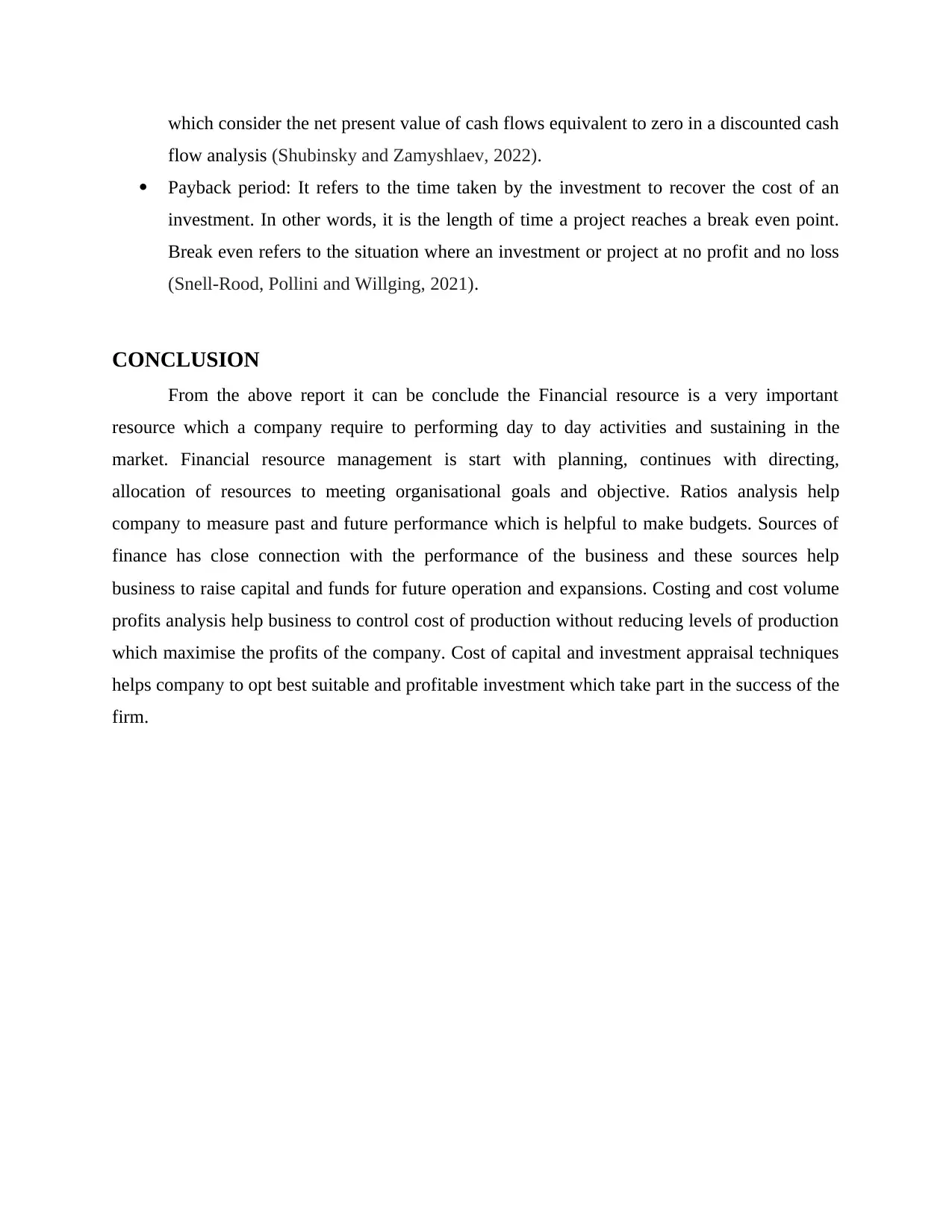
which consider the net present value of cash flows equivalent to zero in a discounted cash
flow analysis (Shubinsky and Zamyshlaev, 2022).
Payback period: It refers to the time taken by the investment to recover the cost of an
investment. In other words, it is the length of time a project reaches a break even point.
Break even refers to the situation where an investment or project at no profit and no loss
(Snell-Rood, Pollini and Willging, 2021).
CONCLUSION
From the above report it can be conclude the Financial resource is a very important
resource which a company require to performing day to day activities and sustaining in the
market. Financial resource management is start with planning, continues with directing,
allocation of resources to meeting organisational goals and objective. Ratios analysis help
company to measure past and future performance which is helpful to make budgets. Sources of
finance has close connection with the performance of the business and these sources help
business to raise capital and funds for future operation and expansions. Costing and cost volume
profits analysis help business to control cost of production without reducing levels of production
which maximise the profits of the company. Cost of capital and investment appraisal techniques
helps company to opt best suitable and profitable investment which take part in the success of the
firm.
flow analysis (Shubinsky and Zamyshlaev, 2022).
Payback period: It refers to the time taken by the investment to recover the cost of an
investment. In other words, it is the length of time a project reaches a break even point.
Break even refers to the situation where an investment or project at no profit and no loss
(Snell-Rood, Pollini and Willging, 2021).
CONCLUSION
From the above report it can be conclude the Financial resource is a very important
resource which a company require to performing day to day activities and sustaining in the
market. Financial resource management is start with planning, continues with directing,
allocation of resources to meeting organisational goals and objective. Ratios analysis help
company to measure past and future performance which is helpful to make budgets. Sources of
finance has close connection with the performance of the business and these sources help
business to raise capital and funds for future operation and expansions. Costing and cost volume
profits analysis help business to control cost of production without reducing levels of production
which maximise the profits of the company. Cost of capital and investment appraisal techniques
helps company to opt best suitable and profitable investment which take part in the success of the
firm.
Paraphrase This Document
Need a fresh take? Get an instant paraphrase of this document with our AI Paraphraser
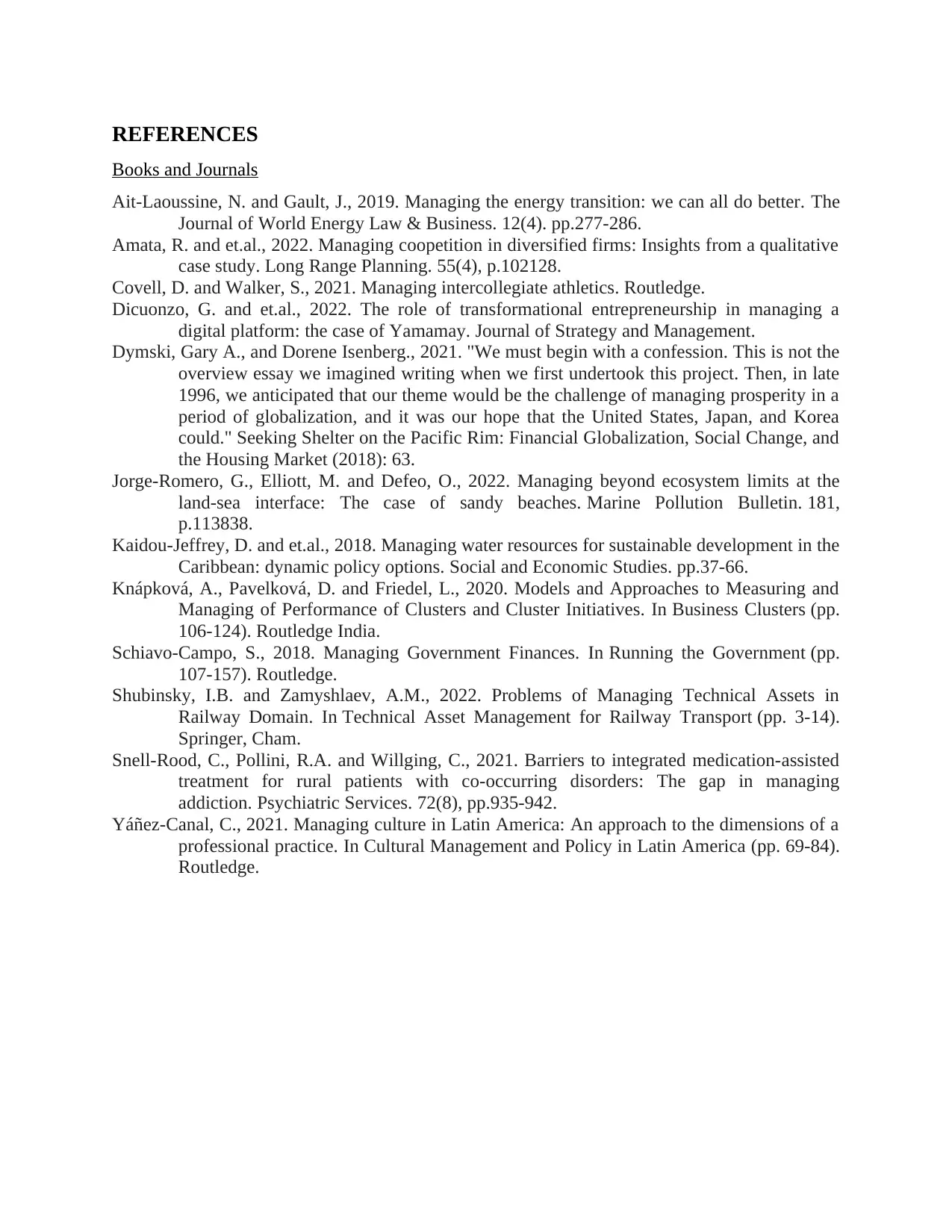
REFERENCES
Books and Journals
Ait-Laoussine, N. and Gault, J., 2019. Managing the energy transition: we can all do better. The
Journal of World Energy Law & Business. 12(4). pp.277-286.
Amata, R. and et.al., 2022. Managing coopetition in diversified firms: Insights from a qualitative
case study. Long Range Planning. 55(4), p.102128.
Covell, D. and Walker, S., 2021. Managing intercollegiate athletics. Routledge.
Dicuonzo, G. and et.al., 2022. The role of transformational entrepreneurship in managing a
digital platform: the case of Yamamay. Journal of Strategy and Management.
Dymski, Gary A., and Dorene Isenberg., 2021. "We must begin with a confession. This is not the
overview essay we imagined writing when we first undertook this project. Then, in late
1996, we anticipated that our theme would be the challenge of managing prosperity in a
period of globalization, and it was our hope that the United States, Japan, and Korea
could." Seeking Shelter on the Pacific Rim: Financial Globalization, Social Change, and
the Housing Market (2018): 63.
Jorge-Romero, G., Elliott, M. and Defeo, O., 2022. Managing beyond ecosystem limits at the
land-sea interface: The case of sandy beaches. Marine Pollution Bulletin. 181,
p.113838.
Kaidou-Jeffrey, D. and et.al., 2018. Managing water resources for sustainable development in the
Caribbean: dynamic policy options. Social and Economic Studies. pp.37-66.
Knápková, A., Pavelková, D. and Friedel, L., 2020. Models and Approaches to Measuring and
Managing of Performance of Clusters and Cluster Initiatives. In Business Clusters (pp.
106-124). Routledge India.
Schiavo-Campo, S., 2018. Managing Government Finances. In Running the Government (pp.
107-157). Routledge.
Shubinsky, I.B. and Zamyshlaev, A.M., 2022. Problems of Managing Technical Assets in
Railway Domain. In Technical Asset Management for Railway Transport (pp. 3-14).
Springer, Cham.
Snell-Rood, C., Pollini, R.A. and Willging, C., 2021. Barriers to integrated medication-assisted
treatment for rural patients with co-occurring disorders: The gap in managing
addiction. Psychiatric Services. 72(8), pp.935-942.
Yáñez-Canal, C., 2021. Managing culture in Latin America: An approach to the dimensions of a
professional practice. In Cultural Management and Policy in Latin America (pp. 69-84).
Routledge.
Books and Journals
Ait-Laoussine, N. and Gault, J., 2019. Managing the energy transition: we can all do better. The
Journal of World Energy Law & Business. 12(4). pp.277-286.
Amata, R. and et.al., 2022. Managing coopetition in diversified firms: Insights from a qualitative
case study. Long Range Planning. 55(4), p.102128.
Covell, D. and Walker, S., 2021. Managing intercollegiate athletics. Routledge.
Dicuonzo, G. and et.al., 2022. The role of transformational entrepreneurship in managing a
digital platform: the case of Yamamay. Journal of Strategy and Management.
Dymski, Gary A., and Dorene Isenberg., 2021. "We must begin with a confession. This is not the
overview essay we imagined writing when we first undertook this project. Then, in late
1996, we anticipated that our theme would be the challenge of managing prosperity in a
period of globalization, and it was our hope that the United States, Japan, and Korea
could." Seeking Shelter on the Pacific Rim: Financial Globalization, Social Change, and
the Housing Market (2018): 63.
Jorge-Romero, G., Elliott, M. and Defeo, O., 2022. Managing beyond ecosystem limits at the
land-sea interface: The case of sandy beaches. Marine Pollution Bulletin. 181,
p.113838.
Kaidou-Jeffrey, D. and et.al., 2018. Managing water resources for sustainable development in the
Caribbean: dynamic policy options. Social and Economic Studies. pp.37-66.
Knápková, A., Pavelková, D. and Friedel, L., 2020. Models and Approaches to Measuring and
Managing of Performance of Clusters and Cluster Initiatives. In Business Clusters (pp.
106-124). Routledge India.
Schiavo-Campo, S., 2018. Managing Government Finances. In Running the Government (pp.
107-157). Routledge.
Shubinsky, I.B. and Zamyshlaev, A.M., 2022. Problems of Managing Technical Assets in
Railway Domain. In Technical Asset Management for Railway Transport (pp. 3-14).
Springer, Cham.
Snell-Rood, C., Pollini, R.A. and Willging, C., 2021. Barriers to integrated medication-assisted
treatment for rural patients with co-occurring disorders: The gap in managing
addiction. Psychiatric Services. 72(8), pp.935-942.
Yáñez-Canal, C., 2021. Managing culture in Latin America: An approach to the dimensions of a
professional practice. In Cultural Management and Policy in Latin America (pp. 69-84).
Routledge.
1 out of 8
Related Documents
Your All-in-One AI-Powered Toolkit for Academic Success.
+13062052269
info@desklib.com
Available 24*7 on WhatsApp / Email
![[object Object]](/_next/static/media/star-bottom.7253800d.svg)
Unlock your academic potential
© 2024 | Zucol Services PVT LTD | All rights reserved.




